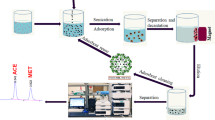Abstract
The efficiency of solid phase extraction (SPE) of DNA on polymer particles is limited by the features of the applied solid support, such as size, hydrophilicity, and functionality and their application in SPE also requires additional steps and compounds to finally obtain sufficient amount of high-quality DNA. The present study describes a preparation of sub-micrometer monodisperse poly(methacrylic acid-co-ethylene dimethacrylate) (PME) particles by precipitation polymerization. The effect of the ethylene dimethacrylate (EDMA) crosslinker concentration on morphology and particle size, which varied from 730 to 900 nm, was investigated. The particles with 5 and 15 wt% EDMA were selected for a study of SPE of plasmid DNA under various adsorption and elution conditions, followed by the enzymatic restriction of isolated DNA to verify a quality the nucleic acid. The particles with 15 wt% EDMA were suitable for the SPE because they retained better colloidal stability during the adsorption without additional induction of DNA conformational change. The quality of isolated DNA was finally verified by enzymatic restriction by restriction endonuclease EcoRI. Moreover, the developed method using PME particles was successfully utilized for DNA isolation from Escherichia coli lysate.






Similar content being viewed by others
References
Julich S, Hotzel H, Gärtner C, Trouchet D, Ahmed MFEM, Kemper N, Tomaso H (2016) Evaluation of a microfluidic chip system for preparation of bacterial DNA from swabs, air, and surface water samples. Biologicals 44:574–580
Rittich B, Španová A, Horák D (2009) Functionalised magnetic microspheres with hydrophilic properties for molecular diagnostic applications. Food Res Int 42:493–498
Smith DS, Maxwell PW, De Boer SH (2005) Comparison of several methods for the extraction of DNA from potatoes and potato-derived products. J Agric Food Chem 53:9848–9859
Moeller JR, Moehn NR, Waller DW, Givnish TJ (2014) Paramagnetic cellulose DNA isolation improves DNA yield and quality among diverse plant taxa. Appl Plant Sci 2:1400048
Young JM, Rawlence NJ, Weyrich LS, Cooper A (2014) Limitations and recommendations for successful DNA extraction from forensic soil samples: a review. Sci Justice 54:238–244
Günal G, Kip Ç, Öğüt SE, Usta DD, Şenlik E, Kibar G, Tuncel A (2017) Human genomic DNA isolation from whole blood using a simple microfluidic system with silica- and polymer-based stationary phases. Mater Sci Eng: C 74:10–20
Poole CF (2003) New trends in solid-phase extraction. TrAC Trends Anal Chem 22:362–373
Rittich B, Španová A (2013) SPE and purification of DNA using magnetic particles. J Sep Sci 36:2472–2485
Sheng W, Wei W, Li J, Qi X, Zuo G, Chen Q, Pan X (2016) Amine-functionalized magnetic mesoporous silica nanoparticles for DNA separation. Appl Surf Sci 387:1116–1124
Tamman SN, Khalil MAF, Gawad EA, Althani A, Zaghloul H, Azzazy HME (2017) Chitosan gold nanoparticles for detection of amplified nucleic acids isolated from sputum. Carbohydr Polym 164:57–63
Lodha A, Ansari N, Shah S, Rao MV, Menon SK (2017) Isolation of PCR ready-human DNA using copper nanoparticles from skeletal remains. Forensic Sci Int 270:146–152
Arakaki A, Shibata K, Mogi T, Hosokawa M, Hatakeyama K, Gomyo H, Taguchi T, Wake H, Tanaami T, Matsunaga T, Tanaka T (2012) Efficient DNA release from PAMAM dendrimer-modified superparamagnetic nanoparticles for DNA recovery. Polym J 44:672–677
Lin YZ, Wang TH, Lin YS, Kuan WC, Lee WC (2014) A novel method to prepare magnetic polymer-based anion exchangers and their application. J Appl Polym Sci 131:40725
Trachtová Š, Obermajer T, Španová A, Matijašić BB, Rogelj I, Horák D, Rittich B (2012) Magnetic hydrophilic poly(2-hydroxyethyl methacrylate-co-glycidyl methacrylate) microspheres for DNA isolation from faeces. Mol Cryst Liq Cryst 555:263–270
Kahánková J, Španová A, Pantůček R, Horák D, Doškař J, Rittich B (2009) Extraction of PCR-ready DNA from Staphylococcus aureus bacteriophages using carboxyl functionalized magnetic nonporous microspheres. J Chromatogr B 877:599–602
Elaissari A, Rodrigue M, Meunier F, Herve C (2001) Hydrophilic magnetic latex for nucleic acid extraction, purification and concentration. J Magn Magn Mater 225:127–133
Liming Z, Zhichao Z, Qianhong W (2006) Preparation of porous magnetic silica microspheres and their application in genomic deoxyribonucleic acids extraction. Chin J Anal Chem 34:923–926
Haddad Y, Xhaxhiu K, Kapel P, Hynek D, Zitka O, Adam V (2016) The isolation of DNA by polycharged magnetic particles: An analysis of the interaction by zeta potential and particle size. Int J Mol Sci 17:550
Ali N, Rampazzo RCP, Costa ADT, Krieger MA (2017) Current nucleic acid extraction methods and their implications to point-of-care diagnostics. BioMed Res Int. https://doi.org/10.1155/2017/9306564
Li X, Zhang J, Gu H (2012) Study on the adsorption mechanism of DNA with mesoporous silica nanoparticles in aqueous solution. Langmuir 28:2827–2834
Melzak KA, Sherwood CS, Turner RFB, Haynes CA (1996) Driving forces for DNA adsorption to silica in perchlorate solutions. J Colloid Interface Sci 181:635–644
Smerkova K, Dostalova S, Vaculovicova M, Kynicky J, Trnkova L, Kralik M, Adam V, Hubalek J, Provaznik I, Kizek R (2013) Investigation of interaction between magnetic silica particles and lambda phage DNA fragment. J Pharm Biomed Anal 86:65–72
Vandeventer PE, Lin JS, Zwang TJ, Nadim A, Johal MS, Niemz A (2012) Multiphasic DNA adsorption to silica surfaces under varying buffer, pH, and ionic strength conditions. J Phys Chem B 116:5661–5670
Vandeventer PE, Mejia J, Nadim A, Johal MS, Niemz A (2013) DNA adsorption to and elution from silica surfaces: influence of amino acid buffers. J Phys Chem B 117:10742–10749
Kaur R, Kumar R, Bachhawat AK (1995) Selective recovery of DNA fragments from silica particles: effect of A-T content and elution conditions. Nucleic Acids Res 23:4932–4933
Katevatis C, Fan A, Klapperich CM (2017) Low concentration DNA extraction and recovery using a silica solid phase. PLoS ONE 12:e0176848
He Z, Zhu Y, Gu H (2013) A new method for the determination of critical polyethylene glycol concentration for selective precipitation of DNA fragments. Appl Microbiol Biotechnol 97:9175–9183
Günal G, Kip Ç, Öğüt SE, Ilhan H, Kibar G, Tuncel A (2017) Comparative DNA isolation behaviours of silica and polymer based sorbents in batch fashion: monodisperse silica microspheres with bimodal pore size distribution as a new sorbent for DNA isolation. Artif Cells Nanomed Biotechnol 46:178–184
Ugelstad J, Stenstad P, Kilaas L, Prestvik WS, Rian A, Nustad K, Herje R, Berge A (1996) Biochemical and biomedical application of monodisperse polymer particles. Macromol Symp 101:491–500
Horák D, Babič M, Macková H, Beneš MJ (2007) Preparation and properties of magnetic nano- and micro-sized particles for biological and environmental separations. J Sep Sci 30:1751–1772
Ahmed EM (2015) Hydrogel: preparation, characterization, and applications: a review. J Adv Res 6:105–121
Goh ECC, Stöver HDH (2002) Cross-linked poly(methacrylic acid-co-poly(ethylene oxide) methyl ether methacrylate) microspheres and microgels prepared by precipitation polymerization: a morphology study. Macromolecules 35:9983–9989
Liu G, Yang X, Wang Y (2007) Preparation of monodisperse hydrophilic polymer microspheres with N,N′-methylenediacrylamide as crosslinker by distillation precipitation polymerization. Polym Int 56:905–913
Bai F, Yang X, Li R, Huang B, Huang W (2006) Monodisperse hydrophilic polymer microspheres having carboxylic acid groups prepared by distillation precipitation polymerization. Polymer 47:5775–5784
Šálek P, Horák D, Bláha M (2013) PEG-modified magnetic hypercrosslinked poly(styrene-co-divinylbenzene) microspheres to minimize sorption of serum proteins. React Funct Polym 73:1122–1129
Heydari A, Sheibani H (2016) Facile polymerization of β-cyclodextrin functionalized graphene or graphene oxide nanosheets using citric acid crosslinker by in situ melt polycondensation for enhanced electrochemical performance. RSC Adv 6:9760–9771
Hawkins TL, O´Connor-Morin T, Roy A, Santillan C (1994) DNA purification and isolation using a solid-phase. Nucleic Acids Res 22:4543–4544
Bai F, Huang B, Yang X, Huang W (2007) Synthesis of monodisperse poly(methacrylic acid) microspheres by distillation-precipitation polymerization. Eur Polym J 43:3923–3932
Kleideiter G, Nordmeier E (1999) Poly(ethylene glycol)-induced DNA condensation in aqueous/methanol containing low-molecular-weight electrolyte solutions.: Part II. Comparison between experiment and theory. Polymer 40:4025–4033
Helene C (1977) Specific recognition of guanine bases in protein-nucleic acid complexes. FEBS Lett 74:10–13
Shi B, Shin YK, Hassanali AA, Singer SJ (2015) DNA binding to the silica surface. J Phys Chem B 119:11030–11040
Vetcher AA, Wells RD (2004) Sticky DNA formation in vivo alters the plasmid dimer/monomer ratio. J Biolog Chem 279:6434–6443
Lee WJ, Chang JG, Ju SP (2010) Hydrogen-bond structure at the interfaces between water/poly(methyl methacrylate), water/poly(methacrylic acid), and water/poly(2-aminoethylmethacrylamide). Langmuir 26:12640–12647
Voβ C, Schmidt T, Schleef M, Friehs K, Flaschel E (2003) Production of supercoiled multimeric plasmid DNA for biopharmaceutical application. J Biotechnol 105:205–213
Yetgin S, Balkose D (2015) Calf thymus DNA characterization and its adsorption on different silica surfaces. RSC Adv 5:57950–57959
Watrob H, Liu W, Chen Y, Bartlett SG, Jen-Jacobson L, Barkley MD (2001) Solution conformation of EcoRI restriction endonuclease changes upon binding of cognate DNA and Mg2+ cofactor. Biochemistry 40:683–692
Eads CA, Laird PW (2002) DNA methylation protocols, Breaugh MJ (ed); Humana Press: Totowa, p 71
Acknowledgements
This work was supported by the Czech Science Foundation (No. 16-02702S) and the Ministry of Education, Youth and Sports (POLYMAT #LO1507).
Author information
Authors and Affiliations
Corresponding author
Ethics declarations
Conflict of interest
The authors declare that they have no conflict of interest.
Additional information
Publisher’s Note
Springer Nature remains neutral with regard to jurisdictional claims in published maps and institutional affiliations.
Rights and permissions
About this article
Cite this article
Šálek, P., Filipová, M., Horák, D. et al. Enhanced solid phase extraction of DNA using hydrophilic monodisperse poly(methacrylic acid-co-ethylene dimethacrylate) microparticles. Mol Biol Rep 46, 3063–3072 (2019). https://doi.org/10.1007/s11033-019-04742-6
Received:
Accepted:
Published:
Issue Date:
DOI: https://doi.org/10.1007/s11033-019-04742-6




